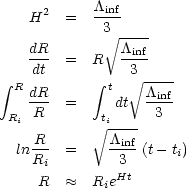


3.1. Friedmann's Equation
 Exponential
Expansion
Exponential
Expansion
One way to describe inflation is that during inflation, a
 inf
term dominates Eq. 11. Thus, during inflation we have,
inf
term dominates Eq. 11. Thus, during inflation we have,
 |
(22) (23) (24) (25) (26) |
where ti and Ri are the time and
scale factor at the beginning of inflation. To get Eq. 26 we have assumed
0  ti << t < te
(where te is the end of inflation) and we
have used Eq. 22.
Equation 26 is the exponential expansion of the Universe during inflation.
The e-folding time is 1/H. The doubling time is (ln 2) /
H. That is, during every interval
ti << t < te
(where te is the end of inflation) and we
have used Eq. 22.
Equation 26 is the exponential expansion of the Universe during inflation.
The e-folding time is 1/H. The doubling time is (ln 2) /
H. That is, during every interval
 t =
1/H, the size of the Universe increases by a factor of
e = 2.718281828... and during every interval
t =
1/H, the size of the Universe increases by a factor of
e = 2.718281828... and during every interval
 t =
(ln 2) / H the size of the Universe doubles.
t =
(ln 2) / H the size of the Universe doubles.